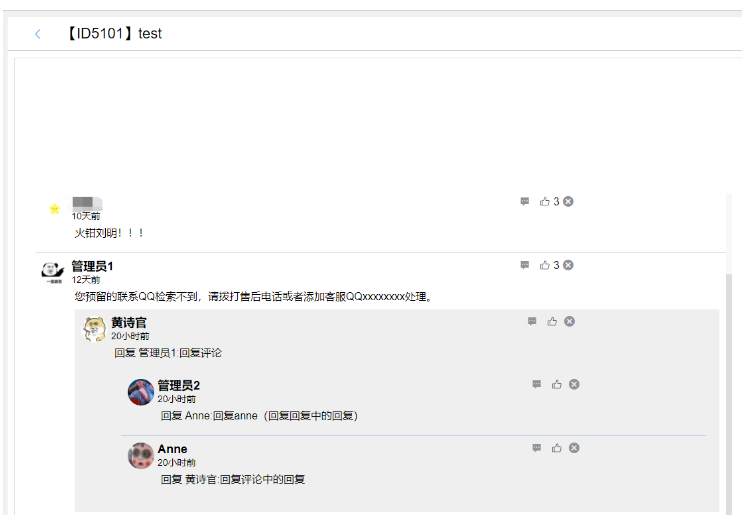这篇文章主要介绍了java怎么实现评论和回复功能的相关知识,内容详细易懂,操作简单快捷,具有一定借鉴价值,相信大家阅读完这篇java怎么实现评论和回复功能文章都会有所收获,下面我们一起来看看吧。
效果展示

总共是两层回复 (回复评论、回复评论下的回复)
数据库设计
评论表(TFW_Comments)和回复内容表(TFW_UserResponse)以及评论回复关系表(TFW_MsgRelation)


数据库设计思路:
注:各位读者自动忽略评论表的服务机构ID字段,这个字段相当于这条评论是在哪个帖子(文章下面)
根据文章ID或者是帖子ID查询评论表获取评论(本文的服务机构ID)。第一层(评论)
根据评论ID并且回复类型等于1的去关系表获取第二层的回复(commentsId)。第二层(评论下的回复)
根据评论ID、回复类型等于2、回复ID去关系表获取第三层回复。第三层(评论下回复中的回复)注:回复ID是它的上级
实现类源码
@Override public Map<String, Object> findComments(JSONObject jsonObject) { data.clear(); String userId = jsonObject.getString("userId"); String role = this.role(jsonObject); if (role.equals("-1")){ //没有权限 data.put("error","-1"); data.put("msg","当前用户没有权限"); return data; } List<Map<String, Object>> info = commentsDao.findComment(jsonObject.getString("fWJLID"),null); //查询点赞次数 int countTag = 0; MsgRelationTag msgRelationTag = new MsgRelationTag(); for (Map item : info){ item.put("inputShow",false); int commentsId = (int) item.get("commentsId"); //查询点赞次数 countTag = msgRelationDao.findCountTagByTagId(commentsId,1); item.put("countTag",countTag); //设置点赞状态 msgRelationTag.setTagId(commentsId); msgRelationTag.setTagType(1); msgRelationTag.setTagUserId(Integer.parseInt(userId)); MsgRelationTag msgTag = msgRelationDao.findMsgTag(msgRelationTag); if (msgTag != null) { item.put("tagStatus",msgTag.getStatus()); }else { item.put("tagStatus",""); } //如果有@id if (item.get("atId") != null){ String content = item.get("content").toString(); StringBuffer tmrAtId = findUserName(item.get("atId").toString()); item.put("content",content+'@'+tmrAtId); } //二级回复数据 List<Map<String, Object>> twoReply = new ArrayList<>(); //所有数据 List<Map<String, Object>> userResponse = userResponseDao.findUserResponse(commentsId, null, "","",null); for (Map userResponseInfo :userResponse){ int userResponseIds = Integer.parseInt(userResponseInfo.get("userResponseId").toString()); //查询点赞次数 countTag = msgRelationDao.findCountTagByTagId(userResponseIds,2); //设置点赞状态 msgRelationTag.setTagId(userResponseIds); msgRelationTag.setTagType(2); msgTag = msgRelationDao.findMsgTag(msgRelationTag); if (msgTag != null) {userResponseInfo.put("tagStatus",msgTag.getStatus());}else {userResponseInfo.put("tagStatus","");} userResponseInfo.put("countTag",countTag); userResponseInfo.put("inputShow",false); Integer responseType = (Integer) userResponseInfo.get("responseType"); for (Map stairReplyInfo : userResponse){ Integer userResponseId = (Integer) stairReplyInfo.get("userResponseId"); int msgRelationId = Integer.parseInt(stairReplyInfo.get("msgRelationId").toString()); //接受者id*/ twoReply = userResponseDao.findUserResponse(msgRelationId, userResponseId,"1","",null); //二级回复数据 for (Map twoReplyItem : twoReply){ int twoReplyId = Integer.parseInt(twoReplyItem.get("userResponseId").toString()); twoReplyItem.put("inputShow",false); //查询点赞次数 countTag = msgRelationDao.findCountTagByTagId(twoReplyId,2); twoReplyItem.put("countTag",countTag); //设置点赞状态 msgRelationTag.setTagId(twoReplyId); msgTag = msgRelationDao.findMsgTag(msgRelationTag); if (msgTag != null) {twoReplyItem.put("tagStatus",msgTag.getStatus());}else {twoReplyItem.put("tagStatus","");} String userRepContent = twoReplyItem.get("userRepContent").toString(); if (twoReplyItem.get("tmrAtId") != null){ StringBuffer tmrAtId = findUserName(twoReplyItem.get("tmrAtId").toString()); twoReplyItem.put("userRepContent",userRepContent+'@'+tmrAtId); } } stairReplyInfo.put("twoReply",twoReply); } } item.put("stairReply",userResponse); } data.put("data",info); data.put("error",0); data.put("msg","查询成功"); return data; }其它的代码可以忽略。主要语句有:
获取帖子下的评论
List<Map<String, Object>> info = commentsDao.findComment(jsonObject.getString("fWJLID"),null);上图根据FWJLID获取评论。(此处可以当成帖子的ID,获取帖子下的评论)一级展示
对应SQL语句(OPT是我的用户表)
select tc.content ,tc.commentsId,convert(varchar(19),tc.startTime,120) as startTime,tc.recipientId ,tc.operatorId,zo.NAME as operatorName,tc.atId,zo.HeadImgUrl as operatorHeadImgUrl from TFW_Comments tc left join zd_opt zo on zo.AID = tc.operatorId where tc.FWJLID = 5101查询结果:

获取评论下的回复
List<Map<String, Object>> userResponse = userResponseDao.findUserResponse(commentsId, null, "","",null);上图根据commentsid获取评论下的回复。(根据评论ID获取回复)二级展示
对应sql语句
select tur.userResponseId,tur.operatorId,tur.recipientId,convert(varchar(19),tur.startTime,120) as startTime,tur.userRepContent,tmr.atId as tmrAtId, tmr.msgRelationId ,tmr.responseType,tmr.replyId, zo.NAME as operatorName, zo1.NAME as recipientName, zo.HeadImgUrl as operatorHeadImgUrl, zo1.HeadImgUrl as recipientHeadImgUrl from TFW_MsgRelation tmr left join TFW_UserResponse tur on tur.userResponseId = tmr.userResponseId left join zd_opt zo on zo.AID = tur.operatorId left join zd_opt zo1 on zo1.AID = tur.recipientId where tmr.commentsId = 47查询结果

获取二级回复
twoReply = userResponseDao.findUserResponse(msgRelationId, userResponseId,"1","",null); //二级回复数据上图是根据评论ID(msgRelationId)和回复ID(userResponseId)去获取二级回复。回复ID也就是父类。就是回复那一条回复的ID。 第三层展示
对应sql
select tur.userResponseId,tur.operatorId,tur.recipientId,convert(varchar(19),tur.startTime,120) as startTime,tur.userRepContent,tmr.atId as tmrAtId, tmr.msgRelationId ,tmr.responseType,tmr.replyId, zo.NAME as operatorName, zo1.NAME as recipientName, zo.HeadImgUrl as operatorHeadImgUrl, zo1.HeadImgUrl as recipientHeadImgUrl from TFW_MsgRelation tmr left join TFW_UserResponse tur on tur.userResponseId = tmr.userResponseId left join zd_opt zo on zo.AID = tur.operatorId left join zd_opt zo1 on zo1.AID = tur.recipientId where tmr.commentsId = 136 and tmr.replyId = 155查询结果

返回页面展示和返回体展示


关于“java怎么实现评论和回复功能”这篇文章的内容就介绍到这里,感谢各位的阅读!相信大家对“java怎么实现评论和回复功能”知识都有一定的了解,大家如果还想学习更多知识,欢迎关注编程网行业资讯频道。





